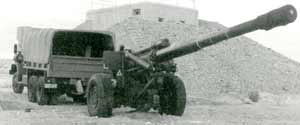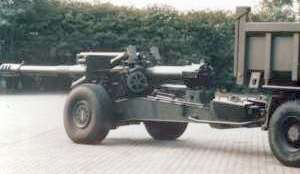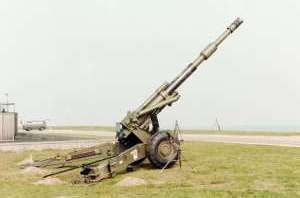| Designation: | M114/39 |
 |
|---|---|---|
| Manufacturer: | RDM Technology BV | |
| Product type: | Weapons & Weapon Systems | |
| Name: | Towed howitzer |
RDM Technology has developed a conversion kit which enables the old US 155 mm M114 towed howitzer to fire new ammunition including ERFB.
RDM Technology converted two Canadian M114s to the M114/39 configuration and these have both completed trials in Canada. At present there are no known plans for Canada to upgrade their M114 systems to the M114/39 standard.
A Memorandum of Understanding (MoU) was signed late in 1986 between Denmark, Netherlands and Norway for a total of 226 M114/39 conversion kits. RDM Technology was the prime contractor, the major subcontractors for offset work being DISA of Denmark and Norsk Forsvarsteknologi AS of Norway.
The first M114/39 was delivered to the Norwegian Army in August 1988 and the project was successfully completed early in 1990.
RDM Technology now offers, in addition to the M114/39 modification kit, brand new guns under the designation M139. These are virtually identical to the M114/39 and their ballistic performance is the same.
As far as is known, RDM Technology has not so far built any brand new M114/39 weapons.
Each of the three countries was responsible for converting those weapons for its own army with each company feeding components to the others.
Following a competition, Bofors Weapon Systems of Sweden was selected to manufacture the barrels for the M114/39 conversion programme; the first sample barrel was delivered in 1984 for extensive tests and the first production barrels were delivered in 1987.
Although deliveries to the three countries were completed in 1990, RDM Technology is still marketing the system and can still produce conversion kits or new guns to order.
In 1993, the Royal Netherlands Army stated that as part of its overall defence cuts only 51 155 mm M114/ 39s would be retained, the rest being disposed of.
The M114/39 calibre modification is accomplished using the maximum number of existing gun parts and new components only where necessary. The major change involves a new 155 mm 39 calibre barrel with a larger chamber, increased twist rifling and a muzzle brake which makes the weapon, with current projectiles and charges, baiiisticaliy similar to the US 155 mm M109A2 self-propelled and US 155 mm M198 towed howitzers.
The fitting of a new 155 mm 39 calibre ordnance has required a number of changes to the carriage including moving the jack forwards and modifying the trails to compensate for the forward shift of the gun's centre of gravity, fitting larger capacity equilibrators with temperature compensating devices, a new metering rod in the recoil system with new seals, and the modification of the gear trains in both the elevating and traversing systems resulting in higher mechanical advantages. Full details of these modifications are as follows:
The new 155 mm 39 calibre barrel has a constant 1:20 twist rifling with 48 lands and grooves. This provides a projectile travel of 5.08 m with a chamber volume of 19,000 cm3. The barrel is autofrettaged to provide maximum fatigue life and is fitted with a screw-block breech mechanism, a conventional type obturator pad and split ring seal obturator.
A three-port high-efficiency muzzle brake is fitted to reduce recoil. In order to adapt the new barrel, the existing cradle has been replaced by a new structure which includes an anti-rotation device.
The original recoil and metering rod, which is in the recoil assembly, has been replaced by one which is optimised with respect to increased muzzle velocity, heavier weight of the ordnance and therefore longer recoil distance. The original seals have been replaced with modern components in order to seal off the larger fluid pressure generated during recoil. This enables the weapon to be fired under all operational conditions without damage. The original front yoke has been replaced with a new structure allowing adaptation of the new ordnance and the provision of attachments for the newequilibrators. The original spring equilibrators were unable to compensate for the increased unbalanced moment and have been replaced by higher capacity pneumatic equilibrators.
The original equilibrator bracket is replaced by one which allows for temperature compensation compatible with the pneumatic equilibrators. The gear trains in the elevating and traversing mechanism have been slightly modified in order to increase the mechanical advantage, which has enabled the handwheel loads to be kept within acceptable limits.
In order to compensate for the shift in the centre of gravity of the weapon, the jack and the float assembly have been moved forward. This is accomplished by securing a spacer to the bottom carriage which in turn holds the jack. This provides a stable firing platform under all conditions.
Due to the forward shift of the centre of gravity, the original trails have been modified and this also allows the crew to manhandle the weapon easily when it is standing on its wheels. All other original components, including the sight and sight mount are retained, simplifying both training and logistic support.
A pneumatic power rammer can be incorporated as an optional extra to permit power loading at all angles of elevation. The pneumatic rammer is powered by compressed air from an air cylinder mounted on the right trail leg.
RDM Technology has developed a VW air-cooled diesel auxiliary power unit that can be installed on the forward part of the carriage. This develops 60 hp and enables the M139and M114/39 to move around under their own power at 10 km/h. This APU remains at the prototype stage.
The upgrade would include replacing the existing 130 mm ordnance with a new 155 mm 45 calibre ordnance which would enable a range of 39,000 m to be achieved firing an Extended Range Full-Bore Base Bleed (ERFB-BB) projectile.
This upgrade is also applicable to the China North Industries Corporation (NORINCO) equivalent of the M-46, the Type 59-1.
Prototype of the RDM Technology 105 mm MOBAT with stabilisers lowered and ordnance elevated (Christopher F Foss) 1999/0055612
First weapons were shipped back to Canada late in 1995 and all work has now been completed.
All of the barrels for these conversions were supplied by Royal Ordnance Nottingham.
Chile has more recently awarded Royal Ordnance a contract to upgrade a substantial number of M101 s and details of this contract are given later in this entry under the RDM Technology/Royal Ordnance teaming arrangement.
Specifications Calibre: 155 mm Barrel length:
(muzzle face to rear face, not incl muzzle brake)
6.016 m Muzzle brake: multibaffle Carriage: split trail Shield: optional Weight: 7,600 kg Length:
(travelling) 10 m Width:
(travelling) 2.44 m Height:
(travelling with lunette 0.737 m from ground) 2.31 m Trunnion height: 1.42 m Track: 2.08 m
Elevation/depression: +63 to -2° Traverse: right 25°, left 24° Rate of fire:
(max) 4 rds/min Range:
(M107 projectile) 18,100 m
(ERFB) 24,600 m
(ERFB-BB) 32,400 m Crew: 11 Towing vehicle: 5 tonne (6 x 6) truck
RDM Technology can either convert existing guns at its own facilities or supply kits to enable users to undertake the conversion themselves.
Production as required. In service with Denmark (96), Netherlands (82) and Norway (48). Brazil and Canada have also upgraded examples of the M114 to the M114/39 configuration for trials purposes.
|
||||||||||||||||||||||||||||||||||||||||||||
|
||||||||||||||||||
 |
 |
 |
 |
 |



